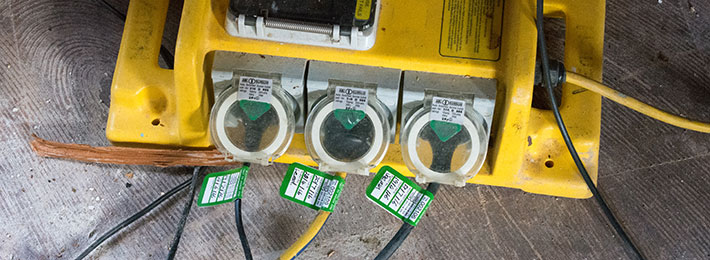Electrical safety on site
29 Jun 2016, Featured, Prove Your Know How, Safety

Working with electricity can be dangerous and accidents are often fatal. Because no device can offer 100% protection from electrocution, it’s important you take electrical safety seriously
The two main ways that electricity can cause harm is either via an electric shock or arc flash. Electric shocks (electric current passing through your body) can cause severe burns and potentially dangerous involuntary movements.
Arc flash (a release of energy) can result in:
- Blast injuries
- Lung injuries
- Ruptured eardrums
- Shrapnel wounds
- Severe burns
- Blindness
General safety tips
You should consider all electrical wires and equipment live until proven otherwise. It’s also important to consider the following:
- Display safety signage when electrical work is under way.
- Inspect cords, plugs and electrical equipment before each use.
- Repair or replace damaged equipment immediately.
- Secure extension cords to the wall or floor using tape (don’t use nails or staples, as they can cause a fire or shock).
- Avoid outlets or cords that have exposed wiring.
- Use extension cords or equipment that are rated for your type of work (ie commercial-graded equipment for work on site).
- Warm or hot outlets can be a sign that unsafe wiring conditions exist.
- Use ladders made with non-conductive materials, such as fibreglass.
- Locate the electrical panel and circuit breakers in case of an emergency.
- Label circuit breakers and fuses clearly.
Inspecting electrical equipment
All electrical appliances, tools and leads should undergo regular testing – what we all know as ‘test and tag’. The frequency of testing a device is determined by where it is used:
- New appliances – before first use.
- Building sites – every three months.
- Factories – every six months.
- Most other applications, such as office equipment, should be tested either yearly, or up to five years in some situations (seek professional advice).
Use the inbuilt testing button to manually test RCDs before use. Where faults are detected with an appliance, it should immediately be marked “out of action” and repairs carried out by a professional.
Common electrical hazards
The biggest risks with electrical equipment include handling damaged equipment or using the incorrect tool for the job. Tools left on while not in use also pose a big risk, so be sure to turn off all equipment when you’ve finished with it.
Worksites can also pose a number of electrical hazards, if power lines, underground services or excessive water are present.
Check sockets are not overloaded and that the supply is earthed when there are many contractors on site.
Workers themselves can also be a hazard. Ensure your team is qualified and authorised to carry out electrical work. In addition, keep an eye on fatigue and ensure that people are not under the influence of drugs or alcohol.
Only someone with a current licence issued by the Electrical Workers Registration Board (EWRB) should be carrying out repairs or modifications to appliances or tools.
Register to earn LBP Points Sign in



